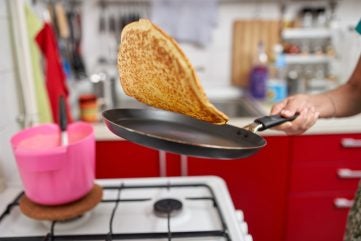
While Shrove Tuesday sees anything from bananas to bacon being paired with pancakes, lesser-highlighted accompaniments are the burns to budding chefs.
England’s NHS says demand for burn treatment soars on pancake day each year, with the burns and scalds page on its website viewed once every 16 seconds.
The NHS outlines the important steps to be taken in case of a mishap, which include a visit to the hospital if the burn is severe enough.
Traditionally, topical antimicrobial applications and dressings are used to treat most kitchen-grade burns while skin grafts are conducted for severe ones.
Many medtech companies have garnered regulatory clearances in the past year to treat burns that go deeper into the skin. Others are looking at digital platforms to help diagnose and triage patients with burn injuries. The wound care management market is expected to total $38.8bn by 2030, with a CAGR of 3.4%.
Medical Device Network looks at two innovative products already at the market and a digital tool in the pipeline.
How well do you really know your competitors?
Access the most comprehensive Company Profiles on the market, powered by GlobalData. Save hours of research. Gain competitive edge.

Thank you!
Your download email will arrive shortly
Not ready to buy yet? Download a free sample
We are confident about the unique quality of our Company Profiles. However, we want you to make the most beneficial decision for your business, so we offer a free sample that you can download by submitting the below form
By GlobalDataFish skin
Kerecis has made a name for itself with its fish skin-derived tissue-transplant products. The Iceland-based company has a patented technology platform that uses wild Atlantic cod skin to treat burns and other acute and chronic wounds. The potential of Kerecis’ devices caught the eye of Danish giant Coloplast, who paid $1.3bn to acquire the company in July 2023. At the time of acquisition, Kerecis was estimated to see revenue grow 30% over the following three years.
Kerecis donated its US Food and Drug Administration (FDA)-cleared Omega3 GraftGuide product to victims of the fires in Hawaii in August 2023. A market model by GlobalData reveals that the tissue-engineered skin substitutes market is forecast to reach almost $3bn by 2033. At the time of acquisition, Kerecis was estimated to see revenue grow 30% over the following three years.
Placental extracellular matrix
Convatec gained FDA clearance for placental extracellular matrix in March 2023. Raw placental tissues are used to create the company’s medical device that uses inherent structural proteins to help with the healing of partial-thickness second-degree burns and complex surgical wounds. The device, called InnovaBurn, is decellularized and sterilised of viruses to allow application on any patient. The device requires neither special storage nor specific placement orientation.
AI
The biggest buzzword in tech has also made it to burn assessments. US-based SpectralMD is using artificial intelligence (AI) and machine learning (ML) to build an imaging tool that predicts the severity of burn injuries. Its DeepView system uses multi-spectral imaging to identify how deep a burn is and assess if a burn specialist is needed.
Conducting an analysis within around 25 seconds, the company says the tech could avoid unnecessary surgeries. The platform is even being adapted for use in military settings, and SpectralMD has partnered with the US Department of Defense to miniaturise the tech into a handheld device. The device is still in clinical trials, with the company completing enrolment in March 2023.







